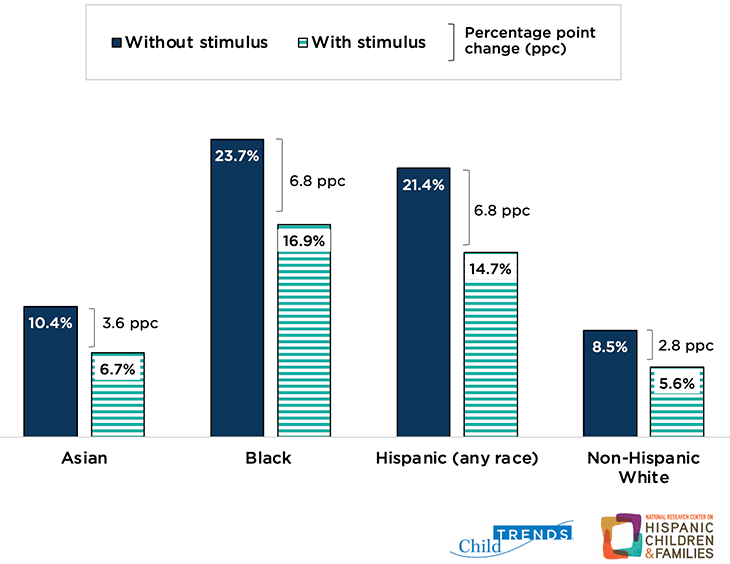Federal Stimulus Payments Kept More Than 2 Million Latino and Black Children Out of Poverty During the COVID-19 Pandemic in 2020
New data from the U.S. Census Bureau show that the federal economic stimulus payments helped protect millions of children from poverty in 2020. These stimulus payments had a particularly large impact on Latino and Black children: According to the Census, the supplemental poverty rate (SPM) for Latino and Black children would have increased by 6.8 percentage points without the first two rounds of stimulus payments,[1] which were distributed starting in mid-April 2020, and again in late December. The SPM differs from the official poverty measure in that it includes the economic impact of income supports and social service benefits to households, including stimulus payments, tax credits, and nutrition assistance, among many others. Out of all the benefits included in calculating the SPM, stimulus payments and refundable tax credits had the largest anti-poverty impact for children across races and ethnicities.
2020 Supplemental Child Poverty Rates Without and With Stimulus Payments by Race/Ethnicity

Source: Figure adapted from Figure 4 of Burns, K., Wilson, D., & Fox, L. E. (2021). Who was lifted out of poverty by stimulus payments? U.S. Census Bureau. Data source: U.S. Census Bureau, Current Population Survey 2021 Annual Social and Economic Supplements (CPS ASEC).
In terms of sheer numbers, Latino children represented the largest racial/ethnic group of children kept out of poverty by the additional income support from the stimulus payments. The latest Census figures show that 1.3 million Latino and 756,000 Black children were kept out of poverty by these federal relief efforts.
The particularly large reduction in the supplemental poverty rate among Latino children attributable to the stimulus payments is especially notable because one in four Latino children are members of mixed-citizenship-status families and were not initially eligible for the first round of stimulus payments. It was not until the second round of stimulus payments in late December 2020 that mixed-status families became eligible (and even then, only family members with valid Social Security numbers were eligible). Additionally, starting in December, mixed-status families could apply retroactively for the first round of payments. Thus, it may be that current estimates of the impact of the stimulus payments on Latino child supplemental poverty rates in 2020 may underestimate the degree to which stimulus payments can improve the economic stability of Latino families.
Despite the powerful success of the 2020 stimulus payments in protecting children from poverty, supplemental poverty rates among Latino and Black children remained high in 2020, at 14.7 percent and 16.9 percent, respectively. For Latino children, this stubbornly high poverty rate may be due in part to the greater challenges that Latino families face in accessing public safety net programs such as TANF, Unemployment Insurance, and the Earned Income Tax Credit.
Footnote
[1] To calculate the impact of various social safety net and federal relief efforts, the Census Bureau calculated what the SPM would be with and without each of the individual components, holding all else constant.
Figure Notes
Respondents were allowed to choose one or more races. “Asian alone,” “Black alone,” and “White alone” refer to people who reported Asian, Black, and White, respectively, and did not report any other race category. The use of this single-race population does not imply that it is the preferred method of presenting or analyzing the data. Because Hispanics may be of any race, data in this report for Hispanics overlap with data for racial groups.
Due to rounding, the differences between the “without stimulus” and “with stimulus” percentages for each racial/ethnic group may differ slightly from the percentage point changes shown at the side.
© Copyright 2025 ChildTrendsPrivacy Statement
Newsletter SignupLinkedInYouTube

